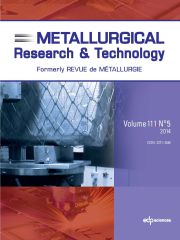Article contents
Effect of TiO2 addition to LF refining slag on the Ti, Al, andcleanliness of Ti-stabilized stainless steel
Published online by Cambridge University Press: 12 August 2014
Abstract
The influence of TiO2 addition to LF refining slag on Ti-stabilized stainlesssteel was evaluated using a vacuum induction furnace at 1873 K. The effect ofCaO-SiO2-MgO-Al2O3 basic slags with different TiO2 contents on the titanium loss,aluminum loss and total oxygen content in the steel was studied. It was observed that theoxidation rate of Ti first decreases and then increases with the increase in the contentof TiO2 in slag andreaches the minimum when 8%TiO2 is added to the slag. However, the change in theoxidation rate of Al shows the opposite tendency. The total oxygen in the molten steelremains unchanged with time when 8%TiO2 is added to the slag, and the total oxygen of theothers increases monotonically with time. The activities of TiO2 and Al2O3 from the calculation of the ionand molecule coexistence theory (IMCT) in the initial slag present the same changetendency, and both first increase and then decrease with the gradual increase inTiO2 in the slagand reach the maximum when 8%TiO2 is added to the slag. The results of a kinetic analysisshowed that the rate-determining step of the oxidation of Ti in the steel is the masstransfer on the slag side, and the rate-determining step of the oxidation of Al in thesteel is the mass transfer on the metal side.
Information
- Type
- Research Article
- Information
- Copyright
- © EDP Sciences 2014
References
- 11
- Cited by

